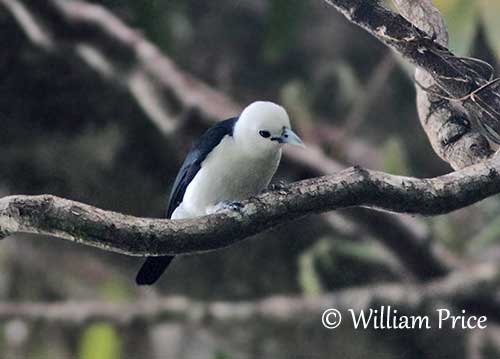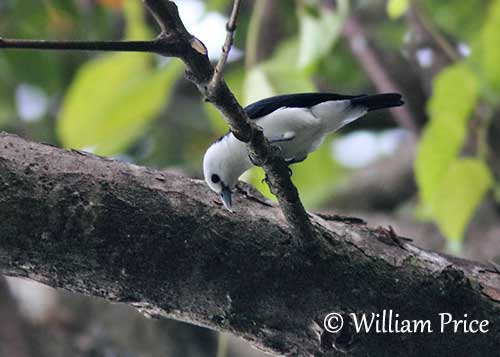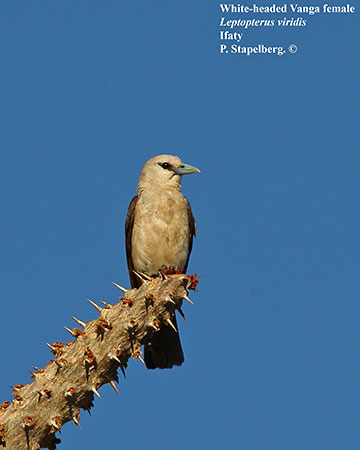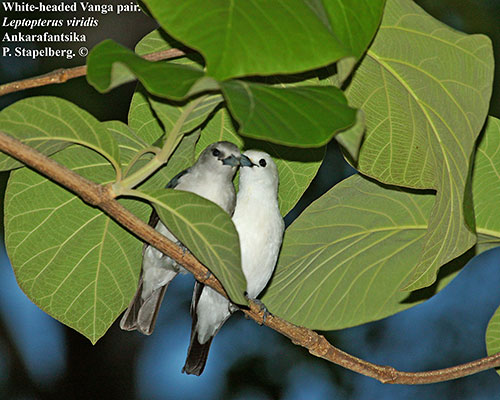
Fr: Artamie à tête blanche
Ang: White-headed Vanga
All: Weißkopfvanga
Esp: Vanga Cabeciblanco
Ita: Vanga testabianca
Nd: Witkopvanga
Sd: vithuvad vanga
Mal: kiborano, Tretreky, Tsakeky, Vanga, vivy, Voromasiaka
Photographers:
William Price
PBase-tereksandpiper & Flickr William Price
Dubi Shapiro
Dubi Shapiro Photo Galleries
Philip Stapelberg
GALLERY
Texte de Nicole Bouglouan
Sources:
HANDBOOK OF THE BIRDS OF THE WORLD Vol 14 by Josep del Hoyo-Andrew Elliot-David Christie - Lynx Edicions – ISBN: 9788496553507
Birds of the Indian Ocean Islands Par Ian Sinclair, Olivier Langrand - ISBN: 1868729567, 9781868729562- Editeur: Struik, 2003
Birds of Madagascar and the Indian Ocean Islands Par Roger Safford, Adrian Skerrett, Frank Hawkins – ISBN: 1472924118, 9781472924117- Editeur: Bloomsbury Publishing, 2015
Birds of Madagascar: A Photographic Guide Par Pete Morris, Frank Hawkins – ISBN: 0300077556, 9780300077551- Editeur: Yale University Press, 1998
The Birds of Africa: Volume VIII: The Malagasy Region: Madagascar, Seychelles, Comoros, Mascarenes - Par Roger Safford, Frank Hawkins – ISBN: 1408190494, 9781408190494- Editeur: A&C Black, 2013
Cooperative Breeding of the White-headed Vanga Leptopterus viridis, an Endemic Species in Madagascar
Creagus – Bird Families of the World – Vangas - Vanginae
THE VANGAS OF MADAGASCAR by Nick Garbutt
White-headed Vanga
Artamella viridis
Passeriformes Order – Vangidae Family
INTRODUCTION:
The White-headed Vanga is endemic to Madagascar where it frequents all types of native forests from sea-level to 1,500 metres of elevation.
Although their bills are very different, the White-headed Vanga and the Sickle-billed Vanga share close similarities in plumage colour, and this resemblance is especially marked. The present species exhibits sexual dimorphism in plumage.
The White-headed Vanga is occasionally a co-operative breeder, but the helper which is probably a male, shows immature plumage and resembles female. It takes parts in territorial defence and mobbing of predators.
The White-headed Vanga is not currently threatened and it is usually common throughout its range.
DESCRIPTION OF THE BIRD:
Biometrics:
Length: 20 cm
Weight: 44-57 g
The White-headed Vanga male has white head, underparts and small area on the rump. On the underwing, the coverts are white whereas the flight-feathers are blackish.
The upperparts are black with green gloss, including on upperwing and tail, but the primaries are uniformly black.
The stout, conical bill is blue-grey with paler tips. The gape and the mouth are black. The eyes are blackish-brown with narrow, blackish eyering. Legs and feet are blue-grey.

The female resembles male but she has pale grey head with paler throat. There is sometimes a blackish wash on lores and behind the eye, forming an indistinct post-ocular line.
On the upperparts, the small area on the rump is grey, not white.
On the underparts, the breast is pale grey whereas the white belly, flanks and undertail-coverts show some tan wash.
The juvenile resembles male but the crown is dark and the black upperparts show broad brown fringes to feathers.
The immature resembles female but the upperparts are duller and much browner.
SUBSPECIES AND RANGE:
The White-headed Vanga has two subspecies.
A.v. annae is found in W and S Madagascar, S from R Sambirano. This race has slightly longer bill than nominate.
A.v. viridis (described above) occurs in N and E Madagascar.
HABITAT:
The White-headed Vanga is commonly found throughout the island, and especially in all types of native forest, but also in second growth and occasionally savanna and wooded areas quite far from native forest.
The nominate race occurs mainly in evergreen humid forest in the E of the island.
The species is present from sea-level up to 1,500 metres of elevation and sometimes higher.

During the breeding season, this species may sometimes perform co-operative breeding, with a helper, a moulting immature male that helps in territory defence, but it does not take part in chick-feeding and rearing. However, the helper shares preening activities with the monogamous mates.
The copulation occurs during the nest-building period, and is usually initiated by the female courting the male. She crouches on a branch, fluffing her plumage, shooking both wings and tail like a young bird begging for food.
The male does not perform sexual displays but it watches the soliciting female, then approaches her and mounts her.
Male and female share the nesting duties and feed the chicks.

CALLS AND SONGS: SOUNDS BY XENO-CANTO
The White-headed Vanga gives a typical, repeated whistle “yippee-hoo yippee-hoo yippee-hoo” and a variety of loud calls including a short “whert”.
The male usually sings from usual perches throughout the territory.
BEHAVIOUR IN THE WILD:
The White-headed Vanga feeds primarily on invertebrates such as caterpillars, crickets and grasshoppers, and spiders, but it also takes, rarely, small vertebrates such as chameleons. It also consumes some fruits and seeds.
It forages on branches, even near-vertical ones, in middle and upper levels of vegetation. It is rarely seen on the ground. It often hangs upside-down while searching for prey. It forages mainly by gleaning and snatching, but it also probes, removes bark fragments, breaks open dead twigs with its stout bill, in order to disturb and catch hidden insects. The large prey items are dismembered with the bill while holding them with a foot.
The White-headed Vanga often joins other Vangidae in foraging mixed-species flocks.

The White-headed Vanga is sedentary. This species is very similar to the Sickle-billed Vanga in flight but it is much smaller and flies more rapidly and directly.
REPRODUCTION OF THIS SPECIES:
The White-headed Vanga breeds at the end of the dry season, from late September/mid-October to January in NW of Madagascar. This specie breeds sometimes co-operatively, with an immature male as helper.
Both mates build the cup-shaped nest with twigs, plant fibres and spider webs, about 6-19 metres above the ground in tree fork.
The female lays 3 white eggs with darker markings. Both adults incubate during 19 days. The chicks are fed by their parents and fledge 22-24 days after hatching.
While the pair tends the young, the helper takes part in territorial defence and mobbing of predators (lemurs, couas, snakes…). Both male and helper are very aggressive while the female gives warning calls but does not take part in defence behaviour.
PROTECTION / THREATS / STATUS:
The White-headed Vanga is usually common throughout its range except in the S where it is less commonly reported. It is present in several protected areas.
The White-headed Vanga is not globally threatened, and currently evaluated as Least Concern.
